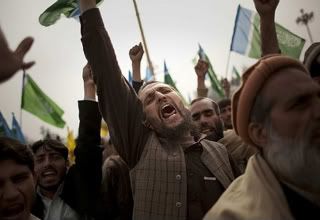( – promoted by buhdydharma )
Little more than a week ago, U.S. President Barack Obama said in an interview with the New York Times:
At the heart of a new Afghanistan policy is going to be a smarter Pakistan policy. As long as you’ve got safe havens in these border regions that the Pakistani government can’t control or reach, in effective ways, we’re going to continue to see vulnerability on the Afghan side of the border. And so it’s very important for us to reach out to the Pakistani government, and work with them more effectively.
How then is expanding the war in Pakistan “smarter” policy? How is this reaching out? The NY Times is reporting on a trial balloon being floated by anonymous senior officials in the administration –
President Obama and his national security advisers are considering expanding the American covert war in Pakistan far beyond the unruly tribal areas to strike at a different center of Taliban power in Baluchistan, where top Taliban leaders are orchestrating attacks into southern Afghanistan.
While having given tacit approval for such attacks, publicly Pakistan has repeatedly protested U.S. missile strikes. Last November, for example, the Pakistani government made an official protest with U.S. ambassador Anne Patterson.
“These kinds of acts are counter-productive … it adds to our problems,” said Yousaf Raza Gilani, Pakistan’s Prime Minister, at the time.
 |
What kind of problems? For one, it provides an easy rallying point for Pakistani Islamists and their supporters to foment anti-U.S. and anti-Western protests.
Missile strikes do not only kill Taliban and al-Qaeda militants, but they also kill civilians. In many of the missile strikes, Pakistani civilians are also killed. Whether or not the Taliban and al-Qaeda are using the civilians as shields is not the point. Each dead civilian is one more reason for a friend or family member to fight back against the U.S.
Yesterday, the Campaign for Innocent Victims in Conflict released a new report “Losing the People: The Costs and Consequences of Civilian Suffering in Afghanistan” (pdf) that found:
The international coalition in Afghanistan is losing public support, one fallen civilian at a time… A once welcoming picture of the population has turned into scenes of frequent, widespread and sometimes violent protests over civilian deaths and a perceived lack of concern by international forces…
Billions of dollars are spent to win, keep and rebuild Afghan communities, but it only takes seeing one family maltreated and ignored by military forces for a community to turn against the international effort.
“Civilian deaths from airstrikes act as a recruiting tool for the Taliban and risk fatally undermining the international effort to provide basic security to the people of Afghanistan,” said Brad Adams, Asia director at Human Rights Watch last September when the report, “‘Troops in Contact’: Airstrikes and Civilian Deaths in Afghanistan” (pdf), was released.
For obvious reasons, more militants creates more problems for the U.S. and NATO too. Both in the form militants that have put the Taliban in control of southern Afghanistan, but also makes military operations in Afghanistan more costly for the U.S. and NATO. The U.S.-led coalition largely relies on supply convoys through Pakistan. When locals are upset because of missile strikes, then militants have an easier time attacking supply depots and convoys in northwest Pakistan such as with this attack yesterday that destroyed 14 NATO trucks.
The Times reports that two high-level reports advocate “broadening the target area” in Pakistan, which so far has been limited to the tribal areas. Baluchistan is “a sprawling province that is under the authority of the central government” and borders southern Afghanistan where the Taliban is entrenched.
Reports by U.S. Gen. David Petraeus and U.S. Lt. Gen. Douglas Lute “have recommended expanding American operations outside the tribal areas if Pakistan cannot root out the strengthening insurgency.” Some U.S. officials claim the extensive C.I.A. Predator and Reaper missile strikes have “forced some leaders of the Taliban and Al Qaeda to flee south toward Quetta” and suggest the attacks “in the tribal areas have been effective at killing 9 of Al Qaeda’s top 20 leaders”.
Many American intelligence officials say that several of the top Taliban commanders remain in hiding either in the sprawling Afghan refugee camps near Quetta or in some of the city’s Afghan neighborhoods.
Missile strikes or American commando raids in the city of Quetta or the teeming Afghan settlements and refugee camps around the city and near the Afghan border would carry high risks of civilian casualties, American officials acknowledge.
“High risks of civilian casualties” is precisely what Obama should be avoiding in constructing “a smarter Pakistan policy”.
Instead since the first days of his presidency, Obama has been actively pursuing a policy of U.S. missile strikes and now, according to the administration’s latest trial balloon, the administration may seek to expand the use of missile strikes.
If this does become Obama’s long-term strategy, then there is no chance for defeating the Taliban in Pakistan or Afghanistan. The U.S. and NATO may as well withdraw their troops now. Such a move would save Afghan and Pakistani lives, which actually may be a “smarter” strategy in comparison since less civilians killed are fewer militants recruited.
Cross-posted from Daily Kos.

5 comments
Skip to comment form
Author
to my essay last week, “Signs of Obama’s solidifying Afghanistan strategy“.
we wage peace we run the risk of running out of terrists, and how can we keep a war of terror rolling along unless we create more terrists? And what about all those people the missile makers employ? If they start losing jobs the economy could be in trouble…